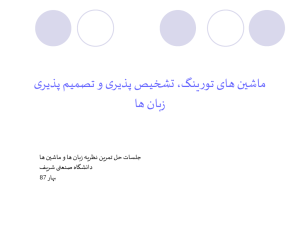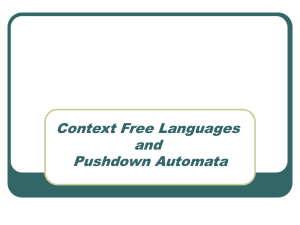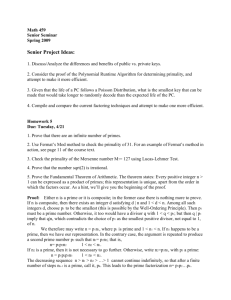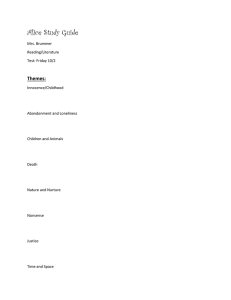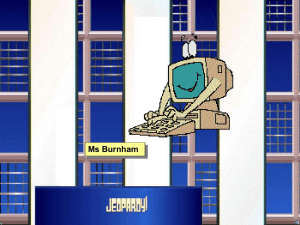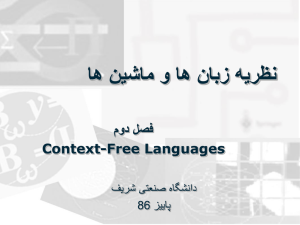Document
advertisement
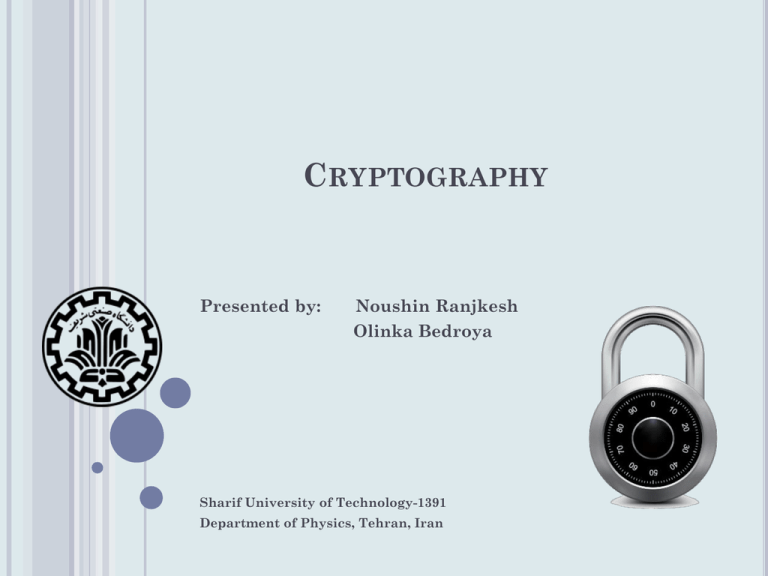
CRYPTOGRAPHY Presented by: Noushin Ranjkesh Olinka Bedroya Sharif University of Technology-1391 Department of Physics, Tehran, Iran CHAPTER 4 THE LANGUAGE BARRIER The impenetrability of unknown languages, the Navajo code talkers of World War II and the decipherment of Egyptian hieroglyphs PURPLE CODE , BATTLE OF MIDWAY 1 /47 2 / 47 بیهودگی بنیادی ماشین های رمزنگاری ،سرعت پایین انتقال اطالعات در نبردهای مناطق محدود ،به ویژه جنگ های اقیانوس آرام ،در نهایت موجب استفاده از کد گوهای ناواجو گردید. 3 / 47 4 / 47 کاستی های استفاده از زبان ناواجو برای رمزگذاری اطالعات در جنگ جهانی دوم نبودن واژه های معادل در زبان ناواجو،برای واژه های نظامی معادل سازی واژه های کاربردی در جنگ با نام حیوانات و واژهای اصیل در زبان ناواجو نام مکان ها و افراد که در هر زبانی ،به صورت مشابه ادا می شود تهیه ی واژه نامه ای از واژه های دارای معادل،در زبان ناواجو برای هر حرف الفبا 5 / 47 6 / 47 The military terms fighter plane amphibious vehicle Submarine The Navajo terms owl (Da-he-tih-hi) frog (Chal) iron fish (Besh-lo) 7 / 47 PACIFIC Pig Ant Cat Ice Fox Ice Cat Bi-sodih Wol-la-chee Moasi Tkin Ma-e Tkin Moasi 8 / 47 DECIPHERING LOST LANGUAGE AND ANCIENT SCRIPTS 9 /47 HIEROGLYPH 10 / 47 HIEROGLYPH زبان مصریان باستا ن از حدود سه هزار سال پیش از میالد یک زبان بسیار زینتی و کاربردی برای معابد به دلیل سختی نوشتار این زبان کم کم به زبان هیراتیک و سپس دموتیک که برای استفاده در روزمره مناسب تر است ،تبدیل شده اند. در حدود چهار قرن پس از میالد مسیح،با گسترش مسیحیت و افزایش قدرت نفوذ کلیسا،زبان یونانی غالب شد و الفبای جدیدی از ترکیب 24حرف از زبان یونانی و 6نشانه از زبان دموتیک ساخته شد و زبان قبطی شکل گرفت. 11 / 47 HIERATIC 12 / 47 13 /47 14 /47 DEMOTIC 15 /47 COPTIC 16 /47 THE ROSETTA STONE 17 /47 سنگ روزتا توسط گروه باستان شناس اعزامی اسکندر در شهر روزتا کشف شد. در موزه ی بریتانیا نگه داری می شود. شامل یک متن ثابت به سه زبان یونانی ،دموتیک و هیروگلیف است. 18 / 47 19 /47 THOMAS YOUNG 20 /47 KARNAK TEMPLE 21 /47 Jean-François Champollion 22 /47 23 /47 24 /47 25 /47 Berenika 26 /47 27 /47 Ptolemaios Cleopatra 28 /47 29 /47 RA (درقبطی به خورشید گفته می شود) )رامسس (RAMSS 30 / 47 CHAPTER 5 ALICE AND BOB GO PUBLIC Modern cryptography, the solution to the so-called key-distribution problem and the secret history of nonsecret encryption ENTERING THE COMPUTER AGE Break of lorenz cypher: sending a same 4000 characters message twice (slightly different) Bill Tutte A Lorenz cypher machine John Tiltman 31 /47 ENTERING THE COMPUTER AGE Max Newman Colossus,delivered 1943 ENIAC ,1945 Thomas H. Flowers 32 /44 ENTERING THE COMPUTER AGE Differences between computer and mechanical encryption: complexity speed Computers deal with binary numbers e.g. computer version of a substitution cipher: Message Message in ASCII Key(DAVID) Ciphertext HELLO 10010001000101100110010011001001111 10001001000001101011010010011000100 00011000000100001101000001010001011 ASCII table 33 /47 ENTERING THE COMPUTER AGE 1947, invention of transistor 1951, Ferranti began to make computers to order. 1953, IBM launched its first computer 1957, introduction of Fortran 1959, invention of the integrated circuit First transistor Ferranti’s computer IBMs first computer 34 /47 KEY DISTRIBUTION Vigenère key Delivering the Enigma monthly code book 1970s, Banks needed to deliver keys to customers 35 /47 KEY DISTRIBUTION Merkle puzzles Quadratic gap is best possible if we treat cipher as a black box oracle [B. Barak and M. Mahmoody-Ghidary. Merkle Puzzles are Optimal] 36 /47 KEY DISTRIBUTION Whitfield Diffie connections of the world wide web. Colors represent different domains. 37 /47 KEY DISTRIBUTION Exchanging keys in person Martin Hellman No key sharing - double locked Asymmetric key… Ralph Merkle 38 /47 ASYMMETRIC KEY What symmetric and asymmetric indicate To build an asymmetric cipher: Alice publishes a public key People lookup for Alice’s Public key They use the public key and encryption method to send Alice messages Alice uses her private key to decrypt 39 /47 ONE WAY FUNCTIONS Mixing colors 40 /47 ONE WAY FUNCTIONS Modular Exponentiation Diffie-Hellman Agree on a public modulus N and a base g Alice chooses a private key x between 1 and N -1 She constructs a public key by computing X=g x mod N Bob chooses a random y and calculate K= X y. Bob sends Alice the enciphered text and Y=g y Alice calculates the K= Y x and deciphers the text 41 /47 ONE WAY FUNCTIONS 42 /47 RSA CRYPTOSYSTEM Ronald Rivest, Adi Shamir and Leonard Adleman. 43 /47 RSA CRYPTOSYSTEM 44 /47 RSA CRYPTOSYSTEM N = 114,381,625,757,888,867,669,235,779,976,146,612,010, 218,296,721,242,362,562,561,842,935,706,935,245,733,897, 830,597,123,563,958,705,058,989,075,147,599,290,026,879, 543,541 q = 3,490,529,510,847,650,949,147,849,619,903,898,133,417, 764,638,493,387,843,990,820,577 p = 32,769,132,993,266,709,549,961,988,190,834,461,413,177, 642,967,992,942,539,798,288,533 Thus far, the best way known to invert RSA is to factor N. The best running time for a fully proved algorithm is Dixon’s Random squares which runs in time ~𝑂(exp( log 𝑁 log(log 𝑁 ))) It took 2 years to factor a 232 digit number, using hundreds of machines P should have 1024 bits 45 /47 THE SECRET HISTORY OF PUBLIC KEY CRYPTOGRAPHY James Ellis, joined GCHQ in 1965 Both new and old GCHQbuildings Malcolm Williamson , joined GCHQ in 1974 Clifford Cocks , joined GCHQ in 1973 46 /47 Brief review of chapter 5 • Birth of computer encryption • Key distribution problem • Asymmetric encryption • Diffie-Hellman cryptosystem • RSA crypto system 47 /47 APPENDIX NUMBER THEORY BASIS FOR RSA CRYPTOSYSTEM Number Theory Background 𝑎𝑥 ≡ 1 𝑚𝑜𝑑𝑛 gcd 𝑎, 𝑛 = 1 𝜙𝑛 is the number of elements in ℤ𝑛 relatively prime to 𝑛 ℤ𝑛∗ = 𝑎 ∈ ℤ𝑛 | gcd 𝑎, 𝑛 = 1 forms an Abeliangroup 𝑎1 . 𝑎2 . 𝑎3 = 𝑎1 . 𝑎2 . 𝑎3 𝑎1 . 𝑎2 = 𝑎2 . 𝑎1 𝑎. 1 = 𝑎 𝑎. 𝑎 −1 = 1 Theorem: If 𝑏 ∈ ℤ𝑛∗ then 𝑏 𝜙𝑛 ≡ 1 𝑚𝑜𝑑𝑛 1 /4 HOW TO FIND PRIME NUMBERS Deterministic AKS primality test Fermat primality test Miller–Rabin primality test Solovay-strassen primality test take a preselected random number of the desired length apply a Fermat primality test Probabilistic apply a certain number of Miller–Rabin tests (depending on the length and the allowed error rate) to get a number which is very probably a prime number. 2 /4 HOW TO FIND PRIME NUMBERS AKS primality test Input: integer n > 1.If n = ab for integers a > 0 and b > 1, output composite. Find the smallest r such that or(n) > log2(n). If 1 < gcd(a,n) < n for some a ≤ r, output composite. If n ≤ r, output prime. For a = 1 to do if (X+a)n≠ Xn+a (mod Xr − 1,n), output composite; Output prime. 3 /4 HOW TO FIND PRIME NUMBERS Fermat primality test Choose random 𝑝 ∈ 21024 2𝑝−1 ≡ 1 𝑝 If so output p as prime; else go back to first step and choose another random number 𝑃𝑟𝑜𝑏𝑎𝑏𝑖𝑙𝑖𝑡𝑦 𝑡ℎ𝑎𝑡 𝑝 𝑖𝑠 𝑛𝑜𝑡 𝑝𝑟𝑖𝑚𝑒 < 2−60 4 /4
